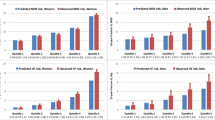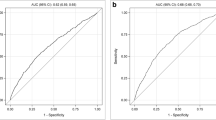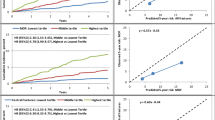Abstract
Summary
The Fracture Risk Evaluation Model (FREM) identifies individuals at high imminent risk of major osteoporotic fractures. We validated FREM on 74,828 individuals from Manitoba, Canada, and found significant fracture risk stratification for all FREM scores. FREM performed better than age alone but not as well as FRAX® with BMD.
Introduction
The FREM is a tool developed from Danish public health registers (hospital diagnoses) to identify individuals over age 45 years at high imminent risk of major osteoporotic fractures (MOF) and hip fracture (HF). In this study, our aim was to examine the ability of FREM to identify individuals at high imminent fracture risk in women and men from Manitoba, Canada.
Methods
We used the population-based Manitoba Bone Mineral Density (BMD) Program registry, and identified women and men aged 45 years or older undergoing baseline BMD assessment with 2 years of follow-up data. From linked population-based data sources, we constructed FREM scores using up to 10 years of prior healthcare information.
Results
The study population comprised 74,828 subjects, and during the 2 years of observation, 1612 incident MOF and 299 incident HF occurred. We found significant fracture risk stratification for all FREM scores, with AUC estimates of 0.63–0.66 for MOF for both sexes and 0.84 for women and 0.65–0.67 for men for HF. FREM performed better than age alone but not as well as FRAX® with BMD. The inclusion of physician claims data gave slightly better performance than hospitalization data alone. Overall calibration for 1-year MOF prediction was reasonable, but HF prediction was overestimated.
Conclusion
In conclusion, the FREM algorithm shows significant fracture risk stratification when applied to an independent clinical population from Manitoba, Canada. Overall calibration for MOF prediction was good, but hip fracture risk was systematically overestimated indicating the need for recalibration.

Similar content being viewed by others
Data availability
Data sharing is not permitted under the Researcher Agreement with Manitoba Health, Seniors and Active Living (MHSAL). However, researchers may apply for data access through the Health Research Ethics Board of the University of Manitoba and the Health Information and Privacy Committee of MHSAL.
References
Kanis JA, Cooper C, Rizzoli R et al (2017) Identification and management of patients at increased risk of osteoporotic fracture: outcomes of an ESCEO expert consensus meeting. Osteoporos Int 28:2023–2034
Kanis J, Norton N, Harvey N, Jacobson T, Johansson H, Lorentzon M, McCloskey E, Willers C, Borgström F (2021) SCOPE 2020: a new scorecard for osteoporosis in Europe. Arch Osteoporos
Kanis JA, Norton N, Harvey NC, Jacobson T, Johansson H, Lorentzon M, McCloskey EV, Willers C, Borgström F (2021) SCOPE 2021: a new scorecard for osteoporosis in Europe. Arch Osteoporos 16:82
Johansson H, Siggeirsdóttir K, Harvey NC, Odén A, Gudnason V, McCloskey E, Sigurdsson G, Kanis JA (2017) Imminent risk of fracture after fracture. Osteoporos Int 28:775–780
Roux C, Briot K (2017) Imminent fracture risk. Osteoporos Int 28:1765–1769
Adachi JD, Berger C, Barron R et al (2019) Predictors of imminent non-vertebral fracture in elderly women with osteoporosis, low bone mass, or a history of fracture, based on data from the population-based Canadian Multicentre Osteoporosis Study (CaMos). Arch Osteoporos 14:53
Rubin KH, Friis-Holmberg T, Hermann AP, Abrahamsen B, Brixen K (2013) Risk assessment tools to identify women with increased risk of osteoporotic fracture: complexity or simplicity? A systematic review. J Bone Miner Res 28:1701–1717
Kanis JA, Johnell O, Oden A, Johansson H, McCloskey E (2008) FRAXTM and the assessment of fracture probability in men and women from the UK. Osteoporos Int 19:385–397
Hippisley-Cox J, Coupland C (2009) Predicting risk of osteoporotic fracture in men and women in England and Wales: prospective derivation and validation of QFractureScores. BMJ 339:b4229
Nguyen ND, Frost SA, Center JR, Eisman JA, Nguyen TV (2007) Development of a nomogram for individualizing hip fracture risk in men and women. Osteoporos Int 18:1109–1117
Nguyen ND, Frost SA, Center JR, Eisman JA, Nguyen TV (2008) Development of prognostic nomograms for individualizing 5-year and 10-year fracture risks. Osteoporos Int 19:1431–1444
Rubin KH, Möller S, Holmberg T, Bliddal M, Søndergaard J, Abrahamsen B (2018) A New Fracture Risk Assessment Tool (FREM) based on public health registries. J Bone Miner Res 33:1967–1979
Skjodt MK, Moller S, Hyldig N, Clausen A, Bliddal M, Sondergaard J, Abrahamsen B, Rubin KH (2021) Validation of the Fracture Risk Evaluation Model (FREM) in predicting major osteoporotic fractures and hip fractures using administrative health data. Bone 147:115934
Leslie WD, Metge C (2003) Establishing a regional bone density program: lessons from the Manitoba experience. J Clin Densitom 6:275–282
Leslie WD, Caetano PA, Macwilliam LR, Finlayson GS (2005) Construction and validation of a population-based bone densitometry database. J Clin Densitom 8:25–30
Lix L, Yogendran M, Shaw S, Burchill C, Metge C, Bond R (2008) Population-based data sources for chronic disease surveillance. Chronic Dis Can 29:31–38
Duerksen DR, Lix LM, Leslie WD (2019) Development of an administrative definition for celiac disease. BMC Res Notes 12:661
Blanchard JF, Ludwig S, Wajda A, Dean H, Anderson K, Kendall O, Depew N (1996) Incidence and prevalence of diabetes in Manitoba, 1986–1991. Diabetes Care 19:807–811
Leslie WD, Schousboe JT, Morin SN, Martineau P, Lix LM, Johansson H, McCloskey EV, Harvey NC, Kanis JA (2020) Measured height loss predicts incident clinical fractures independently from FRAX: a registry-based cohort study. Osteoporos Int 31:1079–1087
Leslie WD, Lix LM, Langsetmo L et al (2011) Construction of a FRAX(R) model for the assessment of fracture probability in Canada and implications for treatment. Osteoporos Int 22:817–827
Fraser LA, Langsetmo L, Berger C et al (2011) Fracture prediction and calibration of a Canadian FRAX® tool: a population-based report from CaMos. Osteoporos Int 22:829–837
Leslie WD, Lix LM, Johansson H, Oden A, McCloskey E, Kanis JA (2010) Independent clinical validation of a Canadian FRAX tool: fracture prediction and model calibration. J Bone Miner Res 25:2350–2358
Rubin KH, Abrahamsen B, Friis-Holmberg T, Hjelmborg JV, Bech M, Hermann AP, Barkmann R, Glüer CC, Brixen K (2013) Comparison of different screening tools (FRAX®, OST, ORAI, OSIRIS, SCORE and age alone) to identify women with increased risk of fracture A population-based prospective study. Bone 56:16–22
Lix LM, Azimaee M, Osman BA, Caetano P, Morin S, Metge C, Goltzman D, Kreiger N, Prior J, Leslie WD (2012) Osteoporosis-related fracture case definitions for population-based administrative data. BMC Public Health 12:301
Epp R, Alhrbi M, Ward L, Leslie WD (2018) Radiological validation of fracture definitions from administrative data. J Bone Miner Res 33:S275
Hanley JA, McNeil BJ (1983) A method of comparing the areas under receiver operating characteristic curves derived from the same cases. Radiology 148:839–843
Svedbom A, Hernlund E, Ivergård M, Compston J, Cooper C, Stenmark J, McCloskey EV, Jönsson B, Kanis JA (2013) Osteoporosis in the European Union: a compendium of country-specific reports. Arch Osteoporos 8:137
Sheer RL, Barron RL, Sudharshan L, Pasquale MK (2020) Validated prediction of imminent risk of fracture for older adults. Am J Manag Care 26:e91–e97
Weycker D, Edelsberg J, Barron R, Atwood M, Oster G, Crittenden DB, Grauer A (2017) Predictors of near-term fracture in osteoporotic women aged ≥65 years, based on data from the study of osteoporotic fractures. Osteoporos Int 28:2565–2571
Reber KC, König HH, Becker C, Rapp K, Büchele G, Mächler S, Lindlbauer I (2018) Development of a risk assessment tool for osteoporotic fracture prevention: a claims data approach. Bone 110:170–176
Almog YA, Rai A, Zhang P et al (2020) Deep learning with electronic health records for short-term fracture risk identification: crystal bone algorithm development and validation. J Med Internet Res 22:e22550
Kanis JA, Oden A, Johansson H, McCloskey E (2012) Pitfalls in the external validation of FRAX. Osteoporos Int 23:423–431
Khalid S, Pineda-Moncusi M, El-Hussein L, et al. (2021) Predicting imminent fractures in patients with a recent fracture or starting oral bisphosphonate therapy: development and international validation of prognostic models. J Bone Miner Res
Kanis JA, Johansson H, Harvey NC et al (2021) The use of 2-, 5-, and 10-year probabilities to characterize fracture risk after a recent sentinel fracture. Osteoporos Int 32:47–54
Black DM, Rosen CJ (2016) Clinical practice Postmenopausal osteoporosis. N Engl J Med 374:254–262
The Lancet Diabetes E (2018) Osteoporosis: a roadmap to close the treatment gap. Lancet Diabetes Endocrinol 6:833
Kanis JA, Svedbom A, Harvey N, McCloskey EV (2014) The osteoporosis treatment gap. J Bone Miner Res 29:1926–1928
Harvey NC, McCloskey EV, Mitchell PJ, Dawson-Hughes B, Pierroz DD, Reginster JY, Rizzoli R, Cooper C, Kanis JA (2017) Mind the (treatment) gap: a global perspective on current and future strategies for prevention of fragility fractures. Osteoporos Int 28:1507–1529
Skjødt MK, Khalid S, Ernst M et al (2020) Secular trends in the initiation of therapy in secondary fracture prevention in Europe: a multi-national cohort study including data from Denmark, Catalonia, and the United Kingdom. Osteoporos Int 31:1535–1544
Abrahamsen B, Skjødt MK, Vestergaard P (2019) Hip fracture rates and time trends in use of anti-osteoporosis medications in Denmark for the period 2005 to 2015: missed opportunities in fracture prevention. Bone 120:476–481
Leslie WD, Tsang JF, Caetano PA, Lix LM (2007) Effectiveness of bone density measurement for predicting osteoporotic fractures in clinical practice. J Clin Endocrinol Metab 92:77–81
Leslie WD, Berger C, Langsetmo L et al (2011) Construction and validation of a simplified fracture risk assessment tool for Canadian women and men: results from the CaMos and Manitoba cohorts. Osteoporos Int 22:1873–1883
Kanis JA, Johansson H, Harvey NC, Gudnason V, Sigurdsson G, Siggeirsdottir K, Lorentzon M, Liu E, Vandenput L, McCloskey EV (2020) Adjusting conventional FRAX estimates of fracture probability according to the recency of sentinel fractures. Osteoporos Int 31:1817–1828
Acknowledgements
The authors acknowledge the Manitoba Centre for Health Policy for use of data contained in the Population Health Research Data Repository (HIPC 2016/2017–29). The results and conclusions are those of the authors and no official endorsement by the Manitoba Centre for Health Policy, Manitoba Health, Seniors and Active Living, or other data providers is intended or should be inferred. This article has been reviewed and approved by the members of the Manitoba Bone Density Program Committee.
Funding
LML is supported by a Tier I Canada Research Chair.
Author information
Authors and Affiliations
Corresponding author
Ethics declarations
Ethics approval
The study was approved by the Health Research Ethics Board of the University of Manitoba.
Consent to participate
Not applicable.
Consent for publication
Not applicable.
Conflicts of interest
Michael K. Skjødt: educational grant, UCB; institutional research grant, UCB/Amgen. Eugene McCloskey: nothing to declare for the context of this paper, but numerous ad hoc consultancies/speaking honoraria and/or research funding from Amgen, Bayer, General Electric, GSK, Fresenius Kabi, Hologic, Lilly, Merck Research Labs, Novartis, Novo Nordisk, Nycomed, Ono, Pfizer, ProStrakan, Roche, Sanofi-Aventis, Servier, Tethys, UCB, and Warner-Chilcott. Nicholas Harvey: nothing to declare for the context of this paper, but has received consultancy/lecture fees/honoraria/grant funding from the Alliance for Better Bone Health, Amgen, MSD, Eli Lilly, Servier, Shire, UCB, Consilient Healthcare, Radius Health, Kyowa Kirin, and Internis Pharma. Bo Abrahamsen: institutional research contracts with Novartis, UCB, Kyowa-Kirin. Fees or honoraria from UCB, Amgen, Pharmacosmos. John Kanis: Professor Kanis led the team that developed FRAX as director of the WHO Collaborating Centre for Metabolic Bone Diseases; he has no financial interest in FRAX. William Leslie, Lisa Lix, Lin Yan, Helena Johansson, Sören Möller, and Katrine Hass Rubin: No conflicts of interest.
Additional information
Publisher's note
Springer Nature remains neutral with regard to jurisdictional claims in published maps and institutional affiliations.
Supplementary Information
Below is the link to the electronic supplementary material.
Rights and permissions
About this article
Cite this article
Möller, S., Skjødt, M.K., Yan, L. et al. Prediction of imminent fracture risk in Canadian women and men aged 45 years or older: external validation of the Fracture Risk Evaluation Model (FREM). Osteoporos Int 33, 57–66 (2022). https://doi.org/10.1007/s00198-021-06165-1
Received:
Accepted:
Published:
Issue Date:
DOI: https://doi.org/10.1007/s00198-021-06165-1




